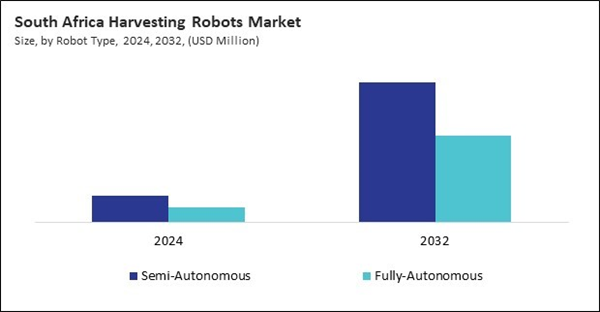The Latin America, Middle East and Africa Harvesting Robots Market is expected to witness market growth of 22.6% CAGR during the forecast period (2025-2032).
The Brazil market dominated the LAMEA Harvesting Robots Market by country in 2024, and is expected to continue to be a dominant market till 2032; thereby, achieving a market value of $286.7 million by 2032. The Argentina market is registering a CAGR of 23.6% during 2025-2032. Additionally, the UAE market is expected to showcase a CAGR of 21.1% during 2025-2032.
The adoption of harvesting robots is gaining momentum worldwide as farmers and agricultural businesses recognize their potential to address labor shortages, rising costs, and the need for sustainable practices. In regions with high labor costs or declining agricultural workforces, such as North America, Europe, and parts of Asia, farmers are increasingly turning to robotic solutions to maintain productivity.
Moreover, large-scale commercial farms, which prioritize efficiency and output, are among the earliest adopters, integrating robots into their operations to automate repetitive tasks and optimize resource use. These enterprises benefit from the scalability of robotic systems, which can operate across extensive fields or in synchronized fleets to cover large areas efficiently.
The LAMEA region, encompassing Latin America, the Middle East, and Africa, represents a rapidly evolving and diverse market for harvesting robots. Agriculture is a crucial sector across these regions, underpinning economies and livelihoods, especially in countries where farming remains a primary source of employment. However, challenges such as labor shortages, climatic unpredictability, and the need for increased productivity have driven interest in automation and robotic solutions. Harvesting robots, designed to improve efficiency, reduce post-harvest losses, and optimize labor use, are gaining traction. The adoption in LAMEA is still in its nascent stages compared to more developed regions but holds significant potential due to the large agricultural base and increasing mechanization trends. Growing demand for food security, coupled with government initiatives aimed at modernizing agriculture, positions LAMEA as a promising market for harvesting robots.
The Brazil market dominated the LAMEA Harvesting Robots Market by country in 2024, and is expected to continue to be a dominant market till 2032; thereby, achieving a market value of $286.7 million by 2032. The Argentina market is registering a CAGR of 23.6% during 2025-2032. Additionally, the UAE market is expected to showcase a CAGR of 21.1% during 2025-2032.
The adoption of harvesting robots is gaining momentum worldwide as farmers and agricultural businesses recognize their potential to address labor shortages, rising costs, and the need for sustainable practices. In regions with high labor costs or declining agricultural workforces, such as North America, Europe, and parts of Asia, farmers are increasingly turning to robotic solutions to maintain productivity.
Moreover, large-scale commercial farms, which prioritize efficiency and output, are among the earliest adopters, integrating robots into their operations to automate repetitive tasks and optimize resource use. These enterprises benefit from the scalability of robotic systems, which can operate across extensive fields or in synchronized fleets to cover large areas efficiently.
The LAMEA region, encompassing Latin America, the Middle East, and Africa, represents a rapidly evolving and diverse market for harvesting robots. Agriculture is a crucial sector across these regions, underpinning economies and livelihoods, especially in countries where farming remains a primary source of employment. However, challenges such as labor shortages, climatic unpredictability, and the need for increased productivity have driven interest in automation and robotic solutions. Harvesting robots, designed to improve efficiency, reduce post-harvest losses, and optimize labor use, are gaining traction. The adoption in LAMEA is still in its nascent stages compared to more developed regions but holds significant potential due to the large agricultural base and increasing mechanization trends. Growing demand for food security, coupled with government initiatives aimed at modernizing agriculture, positions LAMEA as a promising market for harvesting robots.
List of Key Companies Profiled
- Harvest Automation, Inc.
- AGCO Corporation
- Trimble, Inc.
- Clearpath Robotics, Inc.
- AgEagle Aerial Systems, Inc.
- Autonomous Solutions, Inc.
- Locus Robotics
- Agrobot
- Deere & Company
- Yanmar Holdings Co., Ltd.
Market Report Segmentation
By Robot Type
- Semi-Autonomous
- Fully-Autonomous
By Type
- Driverless Tractors
- Dairy Robots
- UAVs
- Material Management
By Farming Environment
- Outdoor
- Indoor
By Country
- Brazil
- Argentina
- UAE
- Saudi Arabia
- South Africa
- Nigeria
- Rest of LAMEA
Table of Contents
Chapter 1. Market Scope & Methodology
Chapter 2. Market at a Glance
Chapter 3. Market Overview
Chapter 4. Competition Analysis - Global
Chapter 5. Key Customer Criteria - Harvesting Robots Market
Chapter 6. Value Chain Analysis of Harvesting Robots Market
Chapter 7. LAMEA Harvesting Robots Market by Robot Type
Chapter 8. LAMEA Harvesting Robots Market by Type
Chapter 9. LAMEA Harvesting Robots Market by Farming Environment
Chapter 10. LAMEA Harvesting Robots Market by Country
Chapter 11. Company Profiles
Companies Mentioned
- Harvest Automation, Inc.
- AGCO Corporation
- Trimble, Inc.
- Clearpath Robotics, Inc.
- AgEagle Aerial Systems, Inc.
- Autonomous Solutions, Inc.
- Locus Robotics
- Agrobot
- Deere & Company
- Yanmar Holdings Co., Ltd.









